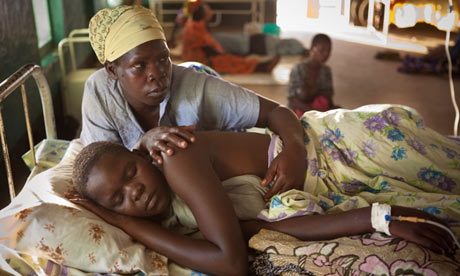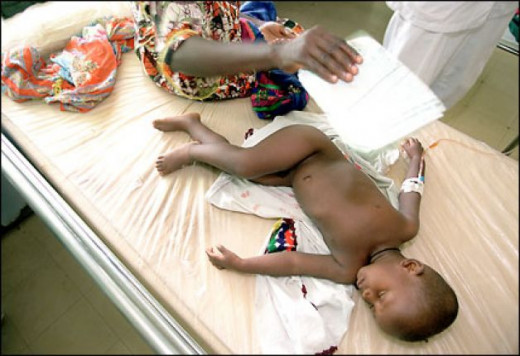Clinical Significance Of Course, Prognosis And General Treatment Of Malaria Infection
Motherly Care On A Daughter With Malaria

Course And Prognosis Of Malaria
The course of all forms of malaria is chronic. Even without treatment, the primary attack subsides, to relapse again. Each relapse may last for several weeks. Relapses are precipitated by travel, intercurrent infection or other forms of stress. The spleen enlarges successively with each relapse and continues to grow bigger. Anemia, jaundice, and Cachexia develop. Hepatosplenomegaly leads to protuberance of the abdomen. The patient gradually becomes home-bound and his working capacity declines while the nutritional inadequacy develops. This is the stage of chronic malaria. Death is due to the acute attack, pernicious complications of intercurrent infection.
After a single attack of malaria, even if further infection is avoided, relapses may occur for 1 to 3 years in the cases of P. Vivax, up to 1 year for P. Ovale and several years (even 20) in the case of P. malariae. In the case of P. falciparum, recrudescence usually go on for 1 year, rarely up to 2 years.
Diagnosis: Malaria should be considered in the diagnosis of all fevers with or without chills and rigor and the suspicion is strengthened by the presence of jaundice, splenomegaly and anemia. Recent visit to endemic areas strengthens the diagnosis. It should be remembered that the primary attach may be atypical and is likely to be missed. Differential diagnosis includes sinusitis, urinary tract infection, infective endocarditis, hepatici amoebiasis, septicemias, relapsing fevers, hemolytic episodes and military tuberculosis. Hepatosplenomegaly seen in chronic malaria has to be distinguished from portal hypertension, hemolytic anemias, lymphomas, leukemias and other parasitic diseases like Kala-azar and trypanosomiasis.
Laboratory Diagnosis: The diagnosis is confirmed by demonstrating the parasite in blood smears taken at the onset of the paroxysm. The general characteristics of plasmodia in Romanowsky-stained films are:
- Location within erythrocytes
- Red chromatic, and
- Blue cytoplasm
The blood film should be scanned completely by an experienced observer before considering it as negative. Repeated examinations of blood collected at subsequent paroxysms are more rewarding.
Injection of adrenaline 0.5 ml subcutaneously 15 minutes should be administered. Prior to blood examination, this singular act increases its positivity rate. Sometimes, bone marrow blood may have to be obtained for demonstrating the parasite when blood film is negative. In patients taking suppressive drugs, these have to be stopped for two days prior to the blood film examination.
Diagnostic values of humoral antibodies are being studied. Indirect fluorescent antibody test is being developed.
A Malaria Pediatric Patient Receiving Treatment

Treatment Of Malaria
Once malaria is diagnosed or it is highly probable, the patient should be put on a specific treatment without delay. They should be kept inside a mosquito net. Use of mosquito repellants like dimethyl phthalate help in reducing transmission. Treatment of malaria can be discussed under different leads:
- Control of the over, attack- suppressive therapy;
- Eradication of infection to prevent relapse; and
- Treatment of the complications in case of P. falciparum infection.
As a general rule, conventional drugs are used. Resistant strains of P. falciparum have to be treated with alternate drugs. Except in emergencies, the drugs are given orally. Parenteral medication is indicated when the patient is having troublesome vomiting and diarrhea or is in coma.
© 2014 Funom Theophilus Makama









